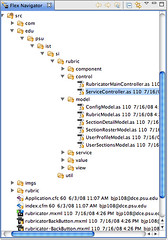So I ordered an iPad because I want to build things for it. My first project was going to be a port of the Rubricator concept — the larger screen and interest of the education community made this seem like a good fit for an iPad application.
Unfortunately, I made a crazy choice in February and started down the path of the Flash CS5 Packager for iPhone rather than commit to the straight-up Apple toolchain I’d been dabbling with for the last year and a half. Why Flash? I was hoping I’d be able to use at least some of my Flex expertise – full-blown Flex components weren’t supported, but ActionScript techniques translate readily back to plain old Flash. This would also give me a chance to experiment with a lightweight AS-only component set (minimalcomps) and an interesting Dependency Injection framework I’d been hearing a lot about (Robotlegs).
Not only was this process awkward, my first crack at the app itself was painfully slow. It was obvious that the techniques I’d developed for Web and desktop application development were not going to be enough to make a reasonable iPhone app, even with a good UI concept. I was beginning to see the dark at the end of the tunnel for this pet project of mine.
But then disaster – Apple pulled the rug out from under the entire Packager for iPhone concept, taking their ball and going home. Boy howdy, I loved middle school. It took a few weeks, but yesterday Adobe finally cried uncle and the proprietary software apologist in me died a little. The two companies that saw me through Microsoft’s bungled hegemony over the Web are now taking shots at each other. Can’t mommy and daddy just get along?
So where do I go now? Do I succumb to Apple’s strong arm tactics and commit to the platform in the way they so desperately want? Do I ditch Apple and run careening for Google and Android? Or do I run to something like PhoneGap, which promises a more open way to develop apps with JavaScript and Web standards.
Anybody wanna buy an iPad, slightly smudged?


